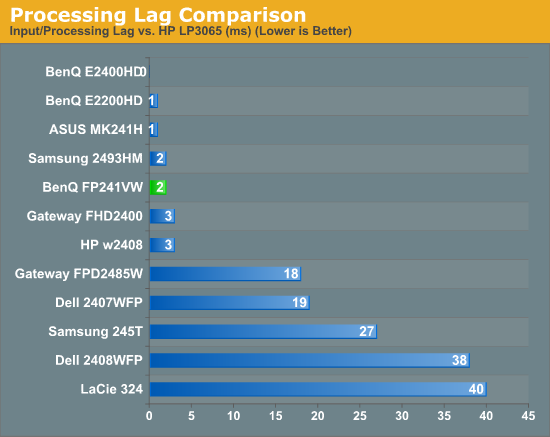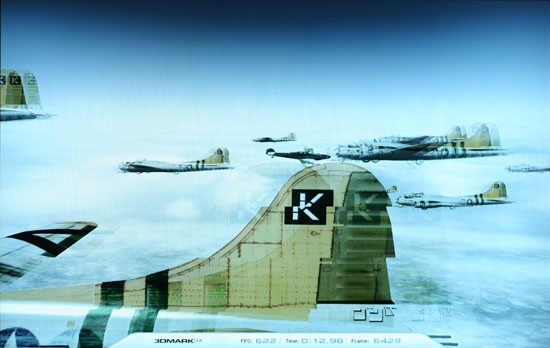Display Lag and Response Time
One of the areas where the A-MVA panel does extremely well is in the areas of display lag and pixel response time. Just to recap, you may have heard complaints about "input lag" on various LCDs, so that's one area we look at in our LCD reviews. We put input lag in quotation marks because while many people call it "input lag", the reality is that this lag occurs somewhere within the LCD panel circuitry, or perhaps even at the level of the liquid crystals. Where this lag occurs isn't the concern; instead, we just want to measure the duration of the lag. That's why we prefer to call it "processing lag" or "display lag".
To test for display lag, we run the Wings of Fury benchmark in 3DMark03, with the output set to the native LCD resolution - in this case 1920x1200. Our test system is a quad-core Q6600 running a Radeon HD 3870 on a Gigabyte GA-X38-DQ6 motherboard - we had to disable CrossFire support in order to output the content to both displays. We connect the test LCD and a reference LCD to two outputs from the Radeon 3870 and set the monitors to run in clone mode.
The reference Monitor is an HP LP3065, which we have found to be one of the best LCDs we currently possess in terms of not having display lag. (The lack of a built-in scaler probably has something to do with this.) While we know some of you would like us to compare performance to a CRT, that's not something we have around our offices anymore. Instead, we are looking at relative performance, and it's possible that the HP LP3065 has 20ms of lag compared to a good CRT - or maybe not. Either way, the relative lag is constant, so even if a CRT is faster at updating, we can at least see if an LCD is equal to or better than our reference display.
While the benchmark is looping, we snap a bunch of pictures of the two LCDs sitting side-by-side (using a relatively fast shutter speed). 3DMark03 shows the runtime with a resolution of 10ms at the bottom of the display, and we can use this to estimate whether a particular LCD has more or less processing lag than our reference LCD. We sort through the images and discard any where the times shown on the LCDs are not clearly legible, until we are left with 10 images for each test LCD. We record the difference in time relative to the HP LP3065 and average the 10 results to come up with an estimated processing lag value, with lower numbers being better. Negative numbers indicate a display is faster than the HP LP3065, while positive numbers mean the HP is faster and has less lag.
It's important to note that this is merely an estimate - whatever the reference monitor happens to be, there are some inherent limitations. For one, LCDs only refresh their display 60 times per second, so we cannot specifically measure anything less than approximately 17ms with 100% accuracy. Second, the two LCDs can have mismatched vertical synchronizations, so it's entirely possible to end up with a one frame difference on the time readout because of this. That's why we average the results of 10 images, and we are confident that our test procedure can at least show when there is a consistent lag/internal processing delay. Here is a summary of our results for the displays we have tested so far.
 |
| Display Input/Processing Lag vs. HP LP3065 | |||||||||||
| One | Two | Three | Four | Five | Six | Seven | Eight | Nine | Ten | Avg. (ms) | |
| ASUS MK241H | 10 | 0 | 0 | 0 | 0 | 0 | 0 | 0 | 0 | 0 | 1 |
| BenQ E2200HD | 0 | 0 | 0 | 10 | 0 | 0 | 0 | 0 | 0 | 0 | 1 |
| BenQ E2400HD | 0 | 0 | 0 | 10 | -10 | 0 | -10 | 0 | 0 | 10 | 0 |
| BenQ FP241VW | 0 | -10 | 0 | 10 | 0 | 10 | 0 | 0 | 10 | 0 | 2 |
| Dell 2407WFP | 10 | 20 | 30 | 20 | 10 | 10 | 30 | 30 | 10 | 20 | 19 |
| Dell 2408WFP | 30 | 40 | 40 | 40 | 30 | 30 | 40 | 30 | 50 | 50 | 38 |
| Gateway FHD2400 | -10 | -10 | 0 | 10 | 10 | 10 | 0 | 10 | 10 | 0 | 3 |
| Gateway FPD2485W | 30 | 10 | 20 | 20 | 20 | 10 | 0 | 30 | 20 | 20 | 18 |
| HP w2408 | 10 | 10 | 0 | 0 | 0 | 0 | 0 | 10 | 0 | 0 | 3 |
| LaCie 324 | 40 | 30 | 40 | 30 | 40 | 50 | 40 | 50 | 50 | 30 | 40 |
| Samsung 245T | 30 | 30 | 30 | 30 | 30 | 20 | 30 | 30 | 20 | 20 | 27 |
| Samsung 2493HM | 0 | 10 | 0 | 0 | 0 | 10 | 0 | -10 | 0 | 10 | 2 |

As you can see, all of the S-PVA panels we have tested to date show a significant amount of input lag, ranging from 20ms up to 40ms. In contrast, the TN and S-IPS panels show little to no processing lag (relative to the HP LP3065). The BenQ FP241VW performs similarly to the TN and IPS panels, with an average display lag of 2ms - not something you would actually notice compared to other LCDs. Obviously, if you're concerned with display lag at all, you'll want to avoid S-PVA panels for the time being. That's unfortunate, considering S-PVA panels perform very well in other areas.
 |
Despite what the manufacturers might advertise as their average pixel response time, we found most of the LCDs are basically equal in this area - they all show roughly a one frame "lag", which equates to a response time of around 16ms. In our experience, processing lag is far more of a concern than pixel response times. Taking a closer look at just the FP241VW, we can see the typical one frame lag in terms of pixel response time. However, the panel does appear to be a little faster in response time than some of the other panels we've tested (notice how the "ghost image" isn't as visible as on the HP LP3065), and we didn't see parts of three frames in any of the test images.
Update: What Causes Display Lag?
After the initial article went live, one of our readers who works in the display industry sent me an email. He provides some interesting information about the causes of image lag. Below is an (edited) excerpt from his email. (He wished to remain anonymous.)
PVA and MVA have inherent drawbacks with respect to LCD response time, especially gray-to-gray. To address this shortcoming, companies have invested in ASICs that perform a trick generically referred to as "overshoot." The liquid crystal (LC) material in *VA responds sluggishly to small voltage changes (a change from one gray level to another). To fix this, the ASIC does some image processing and basically applies an overvoltage to the electrodes of the affected pixel to spur the LC material into rapid movement. Eventually the correct settling voltage is applied to hold the pixel at the required level matching the input drive level.
It's very complicated math taking place in the ASIC in real time. It works well but with an important caveat: it requires a frame buffer. What this means is that as video comes into the panel, there is a memory device that can capture one whole video frame and hold it. After comparing it to the next incoming frame, the required overshoot calculations are made. Only then is the first captured frame released to the panel's timing controller, which is when the frame is rendered to the screen. As you may have already guessed, that causes at least one frame time worth of lag (17ms).
Some companies discovered some unintended artifacts in their overshoot calculations and the only way they saw to correct these was to allow for their algorithm to look ahead by two frames instead of one. So they had to up the memory of the frame buffer and now they started capturing and holding not one but two frames upon which they make their complex overshoot predictions to apply the corrected pixel drive levels and reduce gray-to-gray response time (at the expense of lag time). Again, it works very well for improving response time, but at the expense of causing lag, which gamers hate. That in a nutshell is the basis of around 33ms of the lag measured with S-PVA.
[End Excerpt - the following is not from our reader]
Not every display uses this approach, but this could account for the increase in display lag between earlier S-PVA and later S-PVA panels. It's also important to note that I tested the Dell 2408WFP revision A00, and apparently revision A01 does not have as much lag. I have not been able to confirm this personally, however. The above also suggest that displays designed to provide a higher image quality through various signal processing techniques could end up with more display lag caused by the microchip and microcode, which makes sense. Now all we need are better algorithms and technologies in order to reduce the need for all of this extra image processing -- or as we have seen with some displays (particularly HDTVs), the ability to disable the image processing.










114 Comments
View All Comments
tomoyo - Wednesday, June 17, 2009 - link
AUO seems to have focused on using AMVA and AMVA3 (their latest tech) only on LCD TVs. The only way to get their good stuff is to buy a 32" 1080p LCD TV using their panel. If you look at their current monitor production, it's literally ALL tn-film. Depressing to the extreme.http://auo.com/auoDEV/products.php?sec=monitor&...">http://auo.com/auoDEV/products.php?sec=...mp;func=...
JarredWalton - Wednesday, June 17, 2009 - link
And the worst part is that the page starts out by talking about how great AMVA is... and then they only have TN panels listed. Ugh....tomoyo - Wednesday, June 17, 2009 - link
Going by B5 analogies. Looks like E-IPS is now our last best hope for good LCD panels. S-PVA would interest me more if there was less input lag, but E-IPS seems to have a good chance of giving us good viewing angles + decent panel speed. Now if we could only get LED backlights + 120hz + ergonomic stands in a 16:10 format over a wide variety of sizes, then we'd be in business. I can't imagine that some company out there wouldn't see an opportunity for premium lcd monitors that hardcore gamers/photography/graphics lovers would love to have at moderate prices. I think this area is a completely unrealized market opportunity.I also really dislike the 16:9 format for LCD monitors. It's takes away the balance between fullscreen and widescreen that we have with 16:10. Another cost cutting move that annoys me greatly.
darklight0tr - Wednesday, June 17, 2009 - link
LED backlights on computer LCDs seem to be a very low priority for manufacturers right now. The focus for that tech seems to be LCD TVs, which is disappointing. I'm beginning to think we'll see OLED computer displays before LED backlight LCDs at the rate they're going! The other problem with the LED backlighting is many manufacturers have been pairing it with TN panels. Its like putting a V8 into an econobox.E-IPS looks to be very good, but one of the reasons I went with S-PVA despite the display lag possibility is contrast is a weak point for IPS technology, and that was an important feature to me. Plus, it wasn't widely available in the screen size I was looking for.
If they make 120hz PC LCDs available, I want it to be TRUE 120hz, not the crap they've been selling with LCD TVs. I've seen "120hz" TVs and its obvious that it is an image processing technology that emulates 120hz, and it looks like crap. My friend has it on his TV, and I had to make him turn it off because it was so distracting.
erple2 - Monday, June 22, 2009 - link
To be fair, the bulk of the 120Hz technologies in TV's (particularly flat panel sets) exists solely for de-judder purposes. It conveniently lets you display 24 fps, 30 fps, and 60 fps content at an even multiple.My Sony TV is a 120 Hz TV - I think that there are 2 things that it's used for:
1. "Motion Smoothing" - very cool but super-annoying technology that smooths out and essentially interpolates intermediate frames in slower than 120Hz content. It's somewhat distracting with film - you can think of it as watching a movie, but filmed with a modern high end digital video camera. The "action" is interpolated to appear more than 24 Frames per second. I don't like it.
2. Solid de-juddering. Since most TV's are 60 Hz, when showing content that isn't an exact multiple of 60, the TV has to do some pulldown to get the image to appear right on the TV (the so-called 3:2 pulldown). The 120 Hz "fixes" that, since you don't need to do any complicated pulldown algorithms to get the proper effect.
Since there is no 120 Hz content available that you'd normally watch on a TV (games displayed from a very high-performance computer being the only exception I can think of), I think that it's mostly a marketing talking point.
So, no, generally, the 120 Hz TV's are actually 120 Hz TV's - they do update the display ever 1/120th of a second. However, given LCD's inability to fully RENDER a new pixel that fast is a whole 'nuther issue. 120 Hz translates to 8.333 ms response time necessary to actually change the image on screen.
darklight0tr - Wednesday, June 17, 2009 - link
On top of all that there has been a disturbing move to 16:9 displays. I know they are trying to standardize things, but I really like the extra real estate offered by 16:10. I guess I'm going to have to keep my DELL 2709W until something amazing comes along or it explodes.hyc - Thursday, June 18, 2009 - link
Second that. I want a 42" 1920x1200 monitor to replace my living room TV, but no such beast exists, they're all 1920x1080. Talk about frustrating.The interesting thing about "voting with your wallet" is you can only vote from a selection of what the manufacturers offer you, there's no way to vote for a new product that none of them currently offer. These days, my wallet has been staying closed...
tomoyo - Wednesday, June 17, 2009 - link
The market for LCDS has been terrible for over a year now. Basically all the high quality non-tn films have been discontinued with a few rare exceptions. Also all the high quality height adjustable stands are mostly gone, which makes it almost impossible to put lcds in a position that doesn't cause back/neck/carpel tunnel/etc issues. It's idiotic what we have these days.I'm lucky I have two older dell models that are non-tn film at work and a similar one at home, all with adjustable stands. 1905FP and 2001FP to the rescue. Sadly I can't even imagine changing these out for any new model, because in general the new models are WORSE. I consider myself stuck with these models until a miracle happens.
Now for a secondary screen, generally the best solution I've found for a good panel is to get a 32" LCD TV 1080P. That's one of the only ways to get a moderately usable screen at a low price, which also has FAR more inputs than any Lcd monitor. You can't get $600 Lcd Monitors that are 32" with 3-4 hdmi inputs and massive amounts of composite/component/s-video. The only huge negative is the low resolution, but 1080P is certainly liveable and great as a secondary video watching device.
BugblatterIII - Wednesday, June 17, 2009 - link
I've got a Dell 2407WFP but that's being reallocated so I'm planning to get the Dell 2407WFP. H-IPS screen, portrait rotation, fantastic quality, low latency etcBugblatterIII - Wednesday, June 17, 2009 - link
Of course I meant planning to get the HP LP2475w.